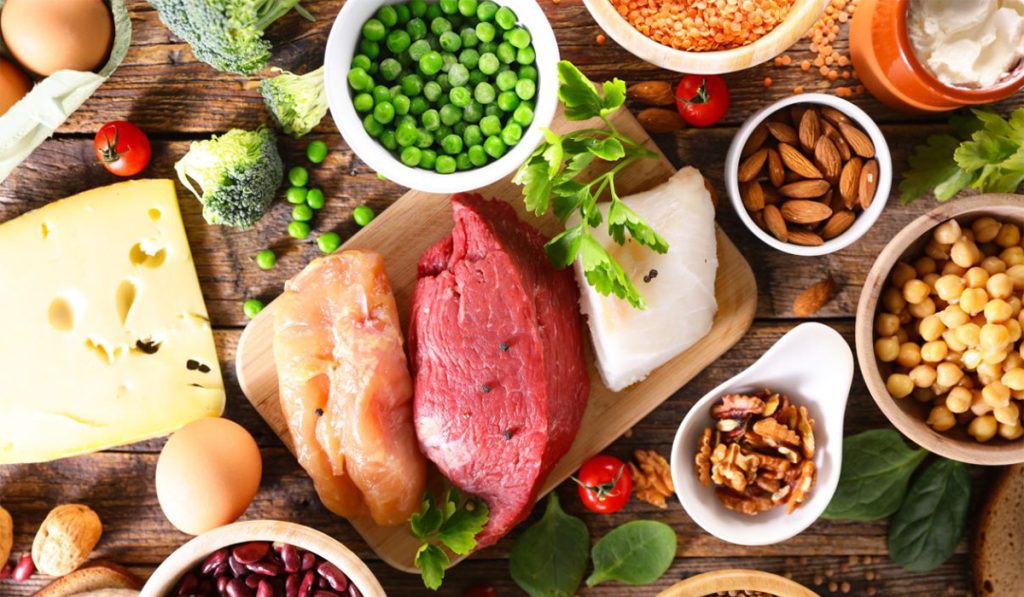by Karen Lindsay, PhD, RDN, Early Career Samueli Endowed Chair, and Diet and Nutrition Counseling at UCI Susan Samueli Integrative Health Institute (SSIHI) and Assistant Professor of Pediatrics, UCI School of Medicine

Women have unique nutritional needs that vary across their life course, from early adult years to pregnancy and postpartum, to menopause and beyond. Ensuring a balanced, nutrient dense diet through each of these life stages is critical to optimize women’s physical and mental health and reduce risk of illness and injury. Protein has long been an overlooked macronutrient concerning women’s health, as greater attention is often paid to carbohydrates and fats with respect to weight management. But protein plays a crucial role in supporting women’s health across the lifespan, as highlighted in several recent scientific studies.
Protein is, quite literally, the building blocks of life. It is required in the formation of muscles, tendons, hair, skin, and nails, as well as supporting the function of hormones and neurotransmitters. There are 20 amino acids that comprise dietary protein and of those, 9 are considered “essential” and must be obtained through diet because our bodies cannot synthesize them. However, there are additional amino acids that become essential to obtain through the diet in many individuals due to illness or during certain life stages such as pregnancy and infancy.

Roles of Protein in Supporting Health
Optimal protein intake helps ensure women can build and maintain lean muscle mass which strengthens bones, optimizes metabolic rate (i.e., burn more calories at rest, supporting healthy weight) and improves mobility and function in all aspects of life. On average, women have less lean muscle mass than men, but many women can benefit from increasing muscle mass to support their health especially with advancing age. Peri- and post-menopausal women are at increased risk of osteoporosis due to declining estrogen levels which promotes bone loss. Establishing a regular resistance exercise program throughout early adult years coupled with adequate protein intake helps increase women’s muscle mass which, in turn, can help prevent bone loss during and after menopause.
Protein can also benefit our metabolism in two ways. Firstly, it is a satiating nutrient, meaning that it keeps us full for longer, preventing overconsumption of less nutritious foods such as refined carbohydrates and sugars to satisfy hunger. Secondly, because protein is digested slowly, by combining a protein-rich food with whole grains or other complex carbohydrates (e.g., vegetables or tubers) during mealtimes, our blood sugar levels remain more balanced. By minimizing large swings in blood sugar levels, this eating pattern can help prevent the development of type 2 diabetes and of gestational diabetes during pregnancy.
Protein Requirements
Protein requirements vary according to age, reproductive status and underlying medical conditions. While the Dietary Guidelines for Americans recommend an intake of 0.36 grams of protein per pound of body weight per day for healthy adults (0.8 grams per kg per day), there is ongoing research into the potential benefits of higher protein intakes. Some studies suggest that protein intakes of 0.7 – 1.0 gram per pound of body weight are needed to support the growth and maintenance of lean muscle mass and do not cause any adverse health effects in people with normal kidney function. Women over age 65 years may require intakes as high as 1.3 grams per pound if they already have decreased bone mineral density to prevent risk of fracture, or to heal from an existing fracture.
Pregnancy is also a unique life stage that increases demands for protein to support the developing fetus and expansion of uterine and placental tissues. Recommended protein intakes during pregnancy are also under debate, with some emerging data to suggest that needs are higher than originally thought, especially as pregnancy progresses (may be as high as 1.5 grams per kg of body weight in the third trimester). This increased protein demand is related to the particularly high needs for the amino acid glycine by the developing fetus, as glycine supports the formation of body tissues and a healthy cardiovascular system.

Protein Sources:
Lean and unprocessed animal protein foods are excellent sources of high quality and easy-to-digest protein, as well as various vitamins and minerals. Animal protein foods provide key nutrients to support healthy pregnancies and babies’ brain and bone development. Examples:
- Red meat and poultry (iron and zinc)
- Fish (omega-3 fats, iodine, selenium)
- Dairy (calcium, iodine, choline)
- Eggs (choline, vitamins ADEK)
Plant-protein foods are great sources of fiber, unsaturated fats, and B vitamins, which support heart health and promote healthy weight in women across the lifespan. These foods are also great sources of folate, which is critical before and during pregnancy to prevent neural tube defects in the developing baby. These foods include:
- Legumes
- Nuts
- Seeds
- Whole soy products e.g., tofu, tempeh
Plant-protein foods are not always easy to digest and the balance and absorption of amino acids from these foods may not meet nutritional needs of all women, especially when protein demands are high (e.g., pregnancy, recovery from illness and injury, or building and strengthening lean muscle mass to prevent osteoporosis). As mentioned above, glycine needs are elevated during pregnancy and this amino acid is primarily found in animal source foods (e.g., meat, fish, dairy) but can also be found in seeds and legumes in lower concentrations. Thus, a balanced omnivorous diet that includes a mix of lean animal proteins and plant proteins supplies an optimal nutrient profile during the critical life stage of pregnancy.
Participate in research studies at Lindsay Lab.
References
Deer R, Volpi E. Protein intake and muscle function in older adults. Curr Opin Clin Nutr Metab Care. 2015;18(3):248-53. doi:10.1097/MCO.0000000000000162
U.S. Department of Agriculture. Dietary guidelines for Americans 2020–2025.
Wallace, Taylor C. PhD. Optimizing Dietary Protein for Lifelong Bone Health: A Paradox Unraveled. Nutrition Today 54(3):p 107-115, 5/6 2019. | DOI: 10.1097/NT.0000000000000340
Mangano K, Sahni S, Kiel D, Tucker K, Dufour A, Hannan M. Dietary protein is associated with musculoskeletal health independently of dietary pattern: the Framingham Third Generation Study. Amer J Clin Nutr. 2017;105(3):714-22. doi:10.3945/ajcn.116.136762
Brawley L, Torrens C, Anthony FW, Itoh S, Wheeler T, Jackson AA, Clough GF, Poston L, Hanson MA. Glycine rectifies vascular dysfunction induced by dietary protein imbalance during pregnancy. J Physiol. 2004 Jan 15;554(Pt 2):497-504. doi: 10.1113/jphysiol.2003.052068.
Rasmussen BF, Ennis MA, Dyer RA, Lim K, Elango R. Glycine, a Dispensable Amino Acid, Is Conditionally Indispensable in Late Stages of Human Pregnancy. J Nutr. 2021 Feb 1;151(2):361-369. doi: 10.1093/jn/nxaa263.